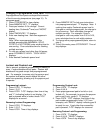
22
Cafe Bavarian Mint
Yield: 14 (6 oz.) servings
1/4 cup powdered nondairy coffee creamer
1/4 cup sugar
1/4 cup instant coffee
2 tablespoons cocoa
5 hard candy peppermints, crushed
Water
1. Combine all ingredients, except water, in small
mixing bowl. (Mix may be stored in airtight
container.)
2. Place 1 tablespoon mixture in serving mug. Fill
with water. Stir to blend. Heat on full power for
1 to 1 1/2 minutes, or until heated through.
Hot Egg Nog
Yield: 4 servings
1 quart milk
4 egg yolks
1/2 cup sugar
1/4 teaspoon cinnamon
1/4 teaspoon nutmeg
1/4 teaspoon vanilla
1. Place milk in casserole. Heat on full power for
6 to 8 minutes, or until heated through. Stir
halfway through heating time.
2. Beat egg yolks with sugar and spices in small
bowl. Stir one cup hot milk into egg mixture
and then gradually blend all of egg mixture into
milk.
3. Heat on full power for 2 to 3 1/2 minutes, or
until warmed. Stir halfway through cooking
time. Stir in vanilla.
Orange Wassail
Yield: 10 (6 oz.) servings
1 1/2 quarts orange juice
2 cups cranberry juice
2 tablespoons honey
6 whole cloves
1 (2-inch) cinnamon stick
1. Combine all ingredients in 3-quart casserole.
Cook, covered, on full power for 14 to 19
minutes, or until boiling. Stir halfway through
cooking time. Continue cooking, covered, on
Cook Level 3 for 10 minutes, or until mixture
has simmered and flavors are blended.
2. Remove spices and serve hot.
Soups and Stews Cooking Guidelines
1. Soups and stews are quickly heated in the
microwave oven. Soups can be heated directly
in serving bowls or mugs, so there are fewer
dishes to wash.
2. Many soups are prepared on full power with
good results. The fast cooking speed allows
soups and stews to maintain a "fresh" flavor.
Soups can be simmered on Cook Level 3 to
blend flavors.
3. Vegetables and meat can be precooked before
adding to soups and stews to shorten the
heating time.
4. Use a container which is considerably larger
than the amount of soup or stew being heated
to avoid boil-overs.
5. Cook soups and stews, covered, as
recommended in recipes for faster, more even
cooking. Cover with a glass lid or heavy-duty
plastic wrap, since these types of coverings are
the most water-vapor-proof. Pierce plastic wrap
slightly before heating. Carefully remove
coverings from soups and stews to avoid steam
burns.
6. When reheating soups or stews, stir the liquid
vigorously or pour from a container into serving
bowls or casserole before reheating.


















